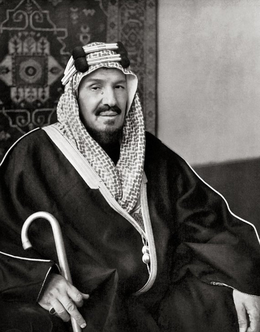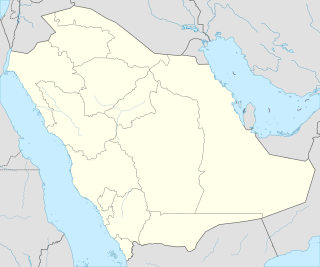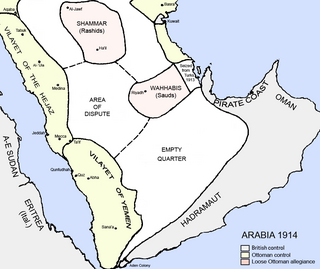Related Research Articles

The history of Saudi Arabia in its current form as a nation state began with the emergence of the Al Saud dynasty in central Arabia in 1744 and the subsequent establishment of the Emirate of Diriyah. The territory that now constitutes Saudi Arabia was the site of several ancient cultures and civilizations. The prehistory of Saudi Arabia shows some of the earliest traces of human activity in the world. The world's second-largest religion, Islam, emerged in modern-day Saudi Arabia. In the early 7th century, the Islamic prophet Muhammad united the population of Arabia and created a single Islamic religious polity. Following his death in 632, his followers rapidly expanded the territory under Muslim rule beyond Arabia, conquering huge and unprecedented swathes of territory in a matter of decades. Arab dynasties originating from modern-day Saudi Arabia founded the Rashidun (632–661), Umayyad (661–750), Abbasid (750–1517) and Fatimid (909–1171) caliphates as well as numerous other dynasties in Asia, Africa and Europe.

Najd, or the Nejd, forms the geographic center of Saudi Arabia accounting for about a third of the country's modern population and, since the Emirate of Diriyah, acting as the base for all unification campaigns by the House of Saud to bring Arabia under a single polity and Islamic jurisprudence.

Abdulaziz bin Abdul Rahman bin Faisal bin Turki bin Abdullah bin Muhammad Al Saud, known in the West as Ibn Saud, was the founder and first king of Saudi Arabia, the "third Saudi state", reigning from 23 September 1932 to his death. He had ruled parts of the kingdom as early as 1902, having previously been the emir, sultan, and king of Nejd and the king of Hejaz.

The Emirate of Diriyah, also transliterated as the Emirate of Dir'iyah, and known as the First Saudi State, was established in the year 1744 when Muhammad ibn Abd al-Wahhab and Prince Muhammad bin Saud formed an alliance to found a socio-religious reform movement to unify the many states of the Arabian Peninsula. In 1744, both Muhammed bin Abd Al Wahhab and Muhammad bin Saud took an oath to achieve their goal.

The Rasheed dynasty, also called Al Rasheed or the House of Rasheed, was a historic Arabian House or dynasty that existed in the Arabian Peninsula between 1836 and 1921. Its members were rulers of the Emirate of Ha'il and the most formidable enemies of the House of Saud, rulers of the Emirate of Nejd. They were centered in Ha'il, a city in northern Najd that derived its wealth from being on the route of the Hajj pilgrimage to Mecca, and was also a commercial center. The rulers of Ha'il were the sons of Abdullah bin Rashid, founder of the dynasty.

The Ikhwan, also Akhwan, was the first Saudi army made up of traditionally nomadic tribesmen which formed a significant military force of the ruler Ibn Saud and played an important role in establishing him as ruler of most of the Arabian Peninsula in the Kingdom of Saudi Arabia. The Ikhwan later became the Saudi Arabian National Guard.
The Banu Bakr bin Wa'il or simply Banu Bakr were an Arabian tribe belonging to the large Rabi'ah branch of Adnanite tribes, which also included Abdul Qays, Anazzah, Taghlib, Banu Shayban and Bani Hanifa. The tribe is reputed to have engaged in a 40-year war before Islam with its cousins from Taghlib, known as the War of Basous. The pre-Islamic poet, Tarafah was a member of Bakr.
Al-Mutairi is one of the largest Arab tribes in the Arab world, especially Saudi Arabia, Iraq, and Kuwait.
The Otaibah is the biggest tribe of the Arabic region originating in Saudi Arabia. which is distributed throughout Saudi Arabia and the Middle East. The Otaibah are descended from the Bedouin. They trace back to the Mudar family and belong to the Qays ʿAylān confederacy through its previous name, Hawazin.
Bani Khalid is an Arab tribal confederation. The tribe ruled Southern Iraq, Kuwait, and Eastern Arabia from the 15th century to the 18th century, and again under the auspices of the Ottoman Empire during the early 19th century. At its greatest extent, the domain of Bani Khalid extended from Iraq in the north to the borders of Oman in the South, and Bani Khalid wielded political influence by ruling the region of Nejd in central Arabia. Most of the tribe's members presently reside in eastern and central Saudi Arabia, while others live in Iraq, Kuwait, Qatar, Bahrain, Palestine, Syria and the United Arab Emirates. The Bani Khalid are both Shia Muslims and Sunni Muslims.

Anezzah is an Arabian tribe in the Arabian Peninsula, Iraq, and the Levant. it is estimated that the tribe of Anezzah Has about 22 - 25 million Arabs Traced back to it making it the most populated Tribe in Arabia.
Al-Ajman or al-'Ijman العجمي is an Arabian tribal confederation in Mid-Eastern Arabian Peninsula, with Ajman spread across Saudi Arabia, Qatar, U.A.E. and the Kuwait.

The Unification of Saudi Arabia was a military and political campaign in which the various tribes, sheikhdoms, city-states, emirates, and kingdoms of most of the Arabian Peninsula were conquered by the House of Saud, or Al Saud. Unification started in 1902 and continued until 1932, when the Kingdom of Saudi Arabia was proclaimed under the leadership of Ibn Saud, creating what is sometimes referred to as the Third Saudi State, to differentiate it from the Emirate of Diriyah, the First Saudi State and the Emirate of Nejd, the Second Saudi State, also House of Saud states.

Al Artawiyah is a Bedouin camp (hijrah) in Riyadh Province, Saudi Arabia, on the road between Riyadh and Kuwait.

The Ikhwan Revolt began in 1927, when the tribesmen of the Otaibah and Mutayr and Ajman rebelled against the authority of Ibn Saud and engaged in cross-border raids into parts of Trans-Jordan, Mandatory Iraq and the Emirate of Kuwait. The relationship between the House of Saud and the Ikhwan deteriorated into an open bloody feud in December 1928. The main instigators of the rebellion were defeated in the Battle of Sabilla, on 29 March 1929. Ikhwan tribesmen and troops loyal to Abd al-Aziz Ibn Saud clashed again in the Jabal Shammar region in August 1929, and Ikhwan tribesmen attacked the Awazim tribe on 5 October 1929. Faisal al-Dawish, the main leader of the rebellion and the Mutair tribe, fled to Kuwait in October 1929 before being detained by the British and handed over to Ibn Saud. Faisal Al-Dawish would die in Riyadh on 3 October 1931 from what appears to have been a heart condition. Government troops had finally suppressed the rebellion on 10 January 1930, when other Ikhwan rebel leaders surrendered to the British. In the aftermath, the Ikhwan leadership was slain, and the remains were eventually incorporated into regular Saudi units. Sultan bin Bajad, one of the three main Ikhwan leaders, was killed in 1931, while al-Dawish died in prison in Riyadh on 3 October 1931.

The Emirate of Jabal Shammar, also known as the Emirate of Haʾil or the Rashidi Emirate, was a state in the northern part of the Arabian Peninsula, including Najd, existing from the mid-nineteenth century to 1921. Jabal Shammar in English is translated as the "Mountain of the Shammar". Jabal Shammar's capital was Ha'il. It was led by a monarchy of the Rashidi dynasty. It included parts of modern-day Saudi Arabia, Iraq, Kuwait, and Jordan.
The Saudi conquest of Hejaz or the Second Saudi-Hashemite War, also known as the Hejaz-Nejd War, was a campaign engaged by Saudi Sultan Abdulaziz Ibn Saud to take over the Hashemite Kingdom of Hejaz in 1924–25, ending with conquest and incorporation of Hejaz into the Saudi domain.
The First Saudi–Hashemite War, also known as the First Nejd–Hejaz War or the al-Khurma dispute, took place in 1918–19 between Abdulaziz Ibn Saud of the Emirate of Nejd and Hasa and the Hashemites of the Kingdom of Hejaz.

The Ottoman era in the history of Arabia lasted from 1517 to 1918. Ottoman degree of control over these lands varied over the four centuries with the fluctuating strength or weakness of the Empire's central authority.

Bani Khalid Emirate The Emirate of Al Hamid from the Bani Khalid tribe is a state that arose in the eastern region of the Arabian Peninsula in year 1669 at the hands of Emir Barak bin Ghurair made his capital in Al- Mubarraz then managed to defeat the Ottoman Empire represented by Lahsa Eyalet and drove them out of the region. The Emirate of Al Hamid ended in year 1796 After the defeat of Barak bin Abdul Mohsen at the hands of The first Saudi state.
References
- ↑ "Geographical and Statistical Gazetteer of the Persian Gulf, 'Omān, and Central Arabia". doi:10.1163/2405-447x_loro_com_040000.Cite journal requires
|journal=(help) - ↑ Hughes, Matthew (2015-08-07), "Ibn Saud (Abd al-Aziz ibn Abd al-Rahman Al Saud) (ca. 1880-1953)", The Encyclopedia of War, Blackwell Publishing Ltd, doi:10.1002/9781444338232.wbeow292, ISBN 9781405190374